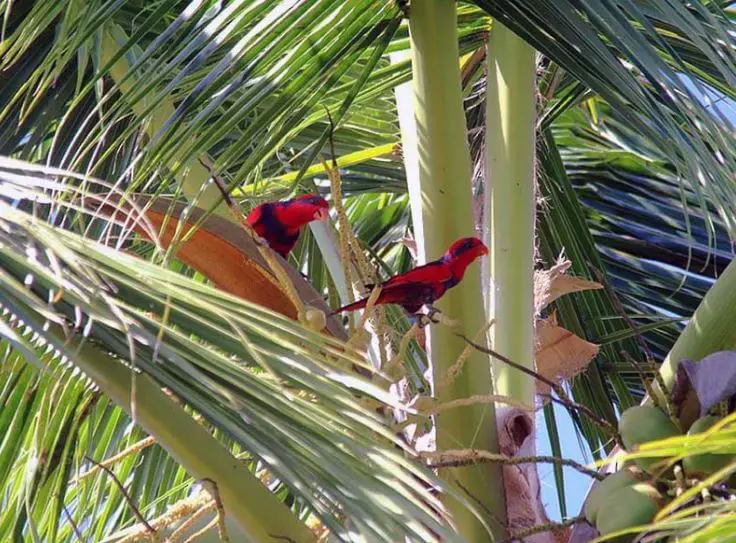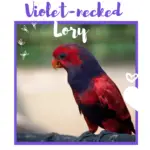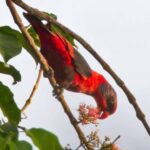Red-and-blue Lory 31 cm. Red, with an orange bill and purplish-blue patch on the mid-to hind crown and broad line from around eye downside of neck to mantle; breastband, mantle and back purplish-blue; scapulars, flight-feathers and thighs black; wing-coverts tipped black; tail reddish-purple above; legs grey.
Red and Blue Lory
SOURCE: Jovan Owimrin
Immature has more blue on the crown (extending to mantle), more black on wings, greyer tail. less defined breastband (mottled grey) and blue scalloping on underparts.

Race talautensis has less black (and more red) on wing-coverts and flight-feathers, and is slightly smaller than nominate; challengeri is also smaller than nominate, with narrower breastband (mottled red), while the line from the eye does not meet mantle.
Size differences between the three races have been disputed, and challengeri might represent non-adult specimens of talautensis.
Systematics History
Editor’s Note: This article requires further editing work to merge existing content into the appropriate Subspecies sections. Please bear with us while this update takes place.
Proposed race challengeri no longer regarded as valid: apparently known only from type specimens, purchased at sea from local canoes purportedly coming from Miangas Is (extreme N Sulawesi subregion), although probably from Nenusa Is (closer to Talaud Is), but birds may have originated from neither, and now thought probably to have been either dispersing or introduced;
Subspecies
Eos histrio challengeri Scientific name definitions
Distribution
Eos histrio talautensis Scientific name definitions
Distribution
Eos histrio histrio Scientific name definitions
Distribution
Distribution
Editor’s Note: Additional distribution information for this taxon can be found in the ‘Subspecies’ article above. In the future, we will develop a range-wide distribution article.
Habitat
Forest and edge, visiting coconut plantations and other open areas to feed.
Movement
Local people report an influx of up to 150 birds each year on Salebabu, Nov–Mar, and large groups have been observed flying between islands elsewhere too.
Diet and Foraging
Seen feeding in coconut (Cocos nucifera), Ficus, Canarium, Lansium domesticum and Syzygium trees, and diet reportedly includes pollen, nectar, fruit and insects.
Sounds and Vocal Behavior
Gives harsh screeching and whistled notes in flight and when gathering at roosts, but is usually quiet while feeding.
Breeding
Main period, Talaud, Apr-May, but also Nov–Dec; latter is reportedly main period on Sangihe. Nest in a hole in a large tree (once a Canarium at 30 m above ground) in both forest and cultivated areas. Eggs are usually two.
Conservation Status
ENDANGERED. CITES I (since Feb 1995). Restricted-range species: present in Sangihe and Talaud EBA. The overall population currently placed at 5500–14,000 mature individuals BirdLife International (2015) Species factsheet: Eos histrio.
Last century uncommon and mainly in hills, Sangihe, but common near the coast on Talaud (presumably the main island, Karakelong), although trapping for cagebird trade had already commenced BirdLife International (2015) Species factsheet: Eos histrio.
in 1978 the status on both islands was much the same; the total population of Talaud was thought to be c. 2000 birds in the early 1990s.
but survey work in 1995 suggested higher numbers and in the late 1990s overall population placed at 8230–21,400 birds with densities of 15·2–28·1 bird/km2 in primary forest and 4·8–19·3 birds/km2 in secondary habitats.
Owing to extensive habitat loss and trade exploitation, the Sangihe population may now be extinct(no sightings in the late 1990s) and it seems likely that the majority, if not all, of the birds seen in 1995 were escaped, or more likely released,
cagebirds brought to Sangihe from the Talaud Is; the tiny, deforested Siau and Ruang cannot now hold viable populations.
red and blue lory
SOURCE: Amazing parrots world
Of the three Talaud Is, the species is extinct on Kabaruang, small numbers survive in the primary forest on Salebabu, while on Karakelong it is still common in the N (communal roost of 400 observed, and another of 500 reported), less so in the S.
However, intensive trapping, no longer possible in Sangihe, continues on Karakelong, with as many as 700 birds being taken in 1992/93, 390–440 in 1994 (the majority of these birds appear to have been smuggled to Singapore) and perhaps 1000–2000 in 1999(c. 80% being sent to the Philippines).
The trade continues with c. 800 birds thought to be exported per year; 111 birds were confiscated from one Philippine trader in Oct 2013, 55 of which survived and were released into the wild in 2014.
The Karakelang Selatan Wildlife Reserve (IUCN Cat. IV; 247 km2) protects suitable habitat, but lacks management and is threatened by agricultural encroachment, illegal logging and fire.
The status of the doubtful race challengeri is completely unknown, but if a population ever really existed on the Nemusa Is, it cannot be large and may even be extinct;
the species was not known to local people in 1995 and 1997, by which time the islands were entirely covered by agricultural plantations and scrub, without any extensive areas of forest.





















